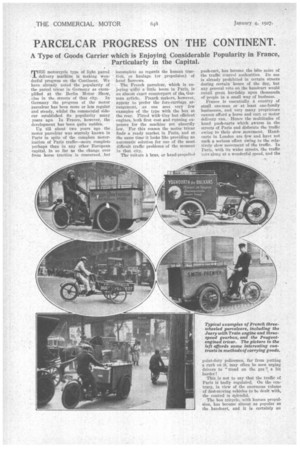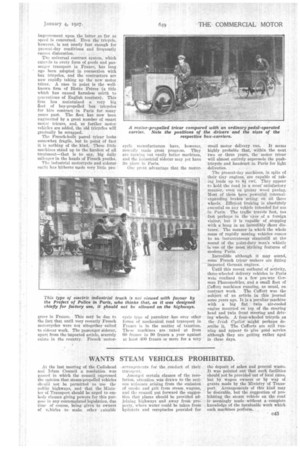PARCELCAR PROGRESS ON THE CONTINENT.
Page 64

Page 65

If you've noticed an error in this article please click here to report it so we can fix it.
A Type of Goods Carrier which is Enjoying Considerable Popularity in France, Particularly in the Capital.
THE motorcycle type of light parcel delivery machine is making wonderful progress on the Continent. We have already noted the popularity of the parcel tricar in Germany as exemplified at the Berlin Motor Show,
r.lso in the streets of that city. In Germany the progress of the motor parcelcar has been more or less regular and steady, whilst the commercial sidecar established its popularity many years ago. In France, however, the development has been quite sudden.
Up till about two years ago the motor parcelcar was scarcely known in Paris in spite of the complete motorization of Paris traffic—more complete perhaps than in any other European capital, in so far as the change over from horse traction is concerned. but incomplete as regards the human traction, or haulage (or propulsion) of hand barrows.
The French parcelcar, which is enjoying quite a little boom in Paris, is an almost exact counterpart of the, German article. French makers, however, appear to prefer the fore-carriage arrangement, as one sees very few examples of the type with the box at the rear. Fitted with tiny but efficient engines, both first cost and running expenses for the machine are absurdly low. For this reason the motor tricar finds a ready market in Paris, and at the same time it looks like providing an automatic solution for one of the most difficult traffic problems of the moment in that city.
The voiture it bras, or hand-propelled push-cart, has become the bete noire of the traffic control authorities. Its use is already prohibited in certain streets during certain hours of the day, but any general veto on the handcart would entail great hardship upon thousands of people in a small way of business.
France is essentially a country of small one-man or at least one-family businesses, and very many proprietors cannot afford a horse and cart or motor delivery van. Hence the multitudes of hand push-carts which swarm in the streets of Paris and dislocate the traffic owing to their slow movement. Handcarts in London are few and have not such a serious effect owing to the relatively slow movement of the traffic. In Paris, with its wider streets, the traffic zets along at a wonderful speed, and the
point-duty policemen, far from putting a curb on it, may often be seen urging drivers to "tread on the gas a bit harder!
This is not to say that the traffic of Paris is badly regulated. On the contrary, in view of the enormous volume of fast-moving vehicles to be dealt with, the control is splendid.
The box tricycle, with human propulsion, has become almost as popular as the handcart, and it is certainly an
improvement upon the latter so far as speed is concerned. Even the tricycle, however, is not nearly fast enough for present-day conditions and frequently
causes dislocation. .
'Die universal contract system, which extends to every form of goods and passenger transport in France, has long ago been adopted in connection with box tricycles, and the contractors are now rapidly taking up the new motor tricar. A case in point is the wellknown firm of Blotto Frres (a title which has caused harmless mirth to generations of English tourists). This firm has maintained a very big fleet of boy-propelled box tricycles for hire contract in Paris for many years past. The fleet has now been augmented by a great number of smart motor triears, and, as further motor vehicles are added, the old tricycles will gradually be scrapped.
The French-built parcel tricar looks somewhat fragile, but in point of fact it is nothing of the kind. These little machines stand up to the hardest of all treatment—that is to say, big daily mileages in the hands of French youths.
The industrial motorcycle and sidecar outfit has hitherto made very little pro gress in France. This ma* be due to the fact that until very recently French motorcycles were not altogether suited to sidecar work. The passenger sidecar, apart from the imported article, scarcely exists in the country. French motor cycle manufacturers have, however, recently made great progress. They are turning out vastly better machines, and the industrial sidecar may yet have its place in Paris.
One great advantage that the motor cycle type of parcelcar has over other forms of mechanical road transport in France is in the matter of taxation. These machines are taxed at from 60 francs to 90 francs a year against at least 400 francs or more for a very small motor delivery van. It seems highly probable that, within the next two or three years, the motor tricar will almost entirely supersede the pushtricycle and handcart in Paris for light deliveries. • • The present-day machines, in spite of their tiny engines, are capable of taking loads up to 4 cwt: They appear to hold the road in a most satisfactory manner, even on greasy wood paving. Most of them have powerful internalexpanding brakes' acting on all three wheels. Efficient braking is absolutely essential on any vehicle intended for use in, Paris. The traffic travels fast, too fast perhaps in the eyes of a foreign visitor, but it is capable of stopping with a bang in an incredibly Aloft distance. The manner in which the whole mass of rapidly moving vehicles comes to an instantaneous standstill at the sound of the point-duty man's whistle is'one Of the most Striking features of modern Paris.
Incredible although it may sound, some French tricar makers are fitting imported German engines.
Until this recent outburst of activity, three-wheeled delivery vehicles in Paris were confined to a few pre-war German Phanomobiles, and a small fleet of Caffort machines running, as usual, on contract work. The Caffort was the subject of an article in this journal some years ago. It is a peculiar machine with a big flat twin air-cooled engine mounted on top of the steering head and twin front steering and driving wheels. A four-wheeled tricycle as the, Irish Cyclist might perhaps 'describe it. The Cafforts are still running and appear to 'give good. service although they are getting rather aged in these days.












































































































